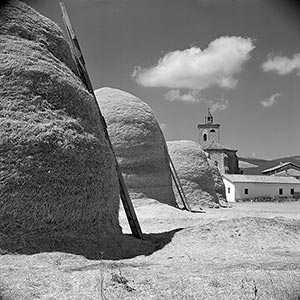Cultural heritage of Ororbia
Nicolás Ardanaz: an evocative view of Ororbia's past
Nicolás Ardanaz Piqué (1910-1982), one of the best non-professional photographers of the 20th century in Navarre, had a special relationship with Ororbia due to his marriage to Resurrección Villanueva. For this reason, the town became the protagonist of a good issue of his images, today guarded, together with the rest of his collection, in the Museum of Navarre. We are talking about a non-professional photographer because photography was the hobby to which he dedicated the free time left by his daily activity in the family drugstore on Calle Mayor, still in operation. His photographic training was self-taught, counting as the only artistic teaching the passage through the academy of the painter Javier Ciga.
His artistic initiation with Ciga would mark Ardanaz's work in his aesthetic assumptions and, above all, in his most common genres and themes: landscape, still life, genre scenes and portraits. He also applied himself to these subjects in Ororbia, giving rise to an extraordinary set of images that bear witness to life in the town before its industrial and urban development development . Most of them are in black and white, preferring the square format, which is not the usual one for the landscape genre.
The landscape photographs, with very luminous skies and deep perspectives, show us some vanished panoramas, such as the river from the confines of Arazuri, without the mass of the Unión Carbide factory. He also turned his gaze to the pajeras, those piles of pyramidal trunk-shaped straw raised on the threshing floors at threshing time, which allow him to establish suggestive interplays of volumes between light and shadow. He achieves a beautiful effect in the image chosen as an illustration, in which the succession of haystacks creates a perspective towards the church tower. Among the urban landscapes, his vision of Angle Street stands out, with the old adobe houses in the shadow of the imposing city hall. Another common topic was the snowy landscape, with perspectives of great nostalgic charge.
One of the most outstanding aspects of Ardanaz's biography is his religious faith, very present in his photographic production and, therefore, in the images taken in Ororbia, which he dedicated to Wayside Cross and the processions. Finally, we must allude to his portraits, which did not arise spontaneously but after careful preparation. Among the Ororbieses portrayed, his wife stands out, of course, who posed on many occasions. In what is possibly Ardanaz's best-known photograph, Resu is caught in the field working at plenary session of the Executive Council in the sun with a bundle of harvest in her hands. The composition is surprising, with a contrapicado emphasized by the diagonal arrangement of the bundle, when he is an author whose work is not noted for its aesthetic experimentation, but, above all, for its evocative power of customs and natural environments that have already disappeared.
ALEGRÍA SUESCUN, D., Flour Mills of Ororbia. Historical-documental study, Concejo de Ororbia, 2015.
GUIJARRO SALVADOR, P., Ororbia: a thousand years of history, Concejo de Ororbia, Kybse, 2015.
MARTÍNEZ ÁLAVA, C. J., TARIFA CASTILLA, M.ª J. and LATORRE ZUBIRI, J., La iglesia de San Julián de Ororbia. History and restoration, Concejo de Ororbia. Foundation for the Conservation of the Historical Heritage of Navarre. Graftech Ibérica, 2014.
ZUBIAUR CARREÑO, F. J., "Catalog de miradas. La Navarra que fotografió Nicolás Ardanaz", in Ricardo Fernández Gracia (coord.), Pvlchrvm: Scripta varia in honorem M.ª Concepción García Gainza, Gobierno de Navarra. University of Navarra, 2011, pp. 838-846.
transcript del Asilo San José: file Contemporáneo de Navarra/Vivienda/1116846.











